How Double Negative Handled Guillermo del Toro's Monster Animation Job
Getting that particular animation right was a bit of a head-scratcher. “We used the regular generic human rig, running the smoke sim, to create the animation,” Butler recalls, “and it didn’t look good. He’s meant to be ectoplasm trying to move like a guy, but it just looked like a guy with smoke coming off him.”
Del Toro counseled Butler, “Just remember Fleischer.” With his background in traditional animation, Butler immediately got the reference.
“I remembered Max Fleischer cartoons from the 1930s and 1940s being rubber-hose animation, so we built that facility into the human rig,” Butler explains. The riggers added an extra set of controls that let the animators stretch Johann’s semi-human figure in un-realistic ways. “Every time he’d move his hand, we would stretch his arm so it got left behind as if it were made of smoke. His arm would triple in length, and we were able to create curlicue shapes with his hands. We were able to art-direct the smoke to complement what the actor had to do.”
It’s an example of what went right on the production, which encouraged healthy collaboration between departments at Double Negative. No longer could the animators work on their own island – problem-solving on Hellboy II involved smart VFX artists knocking their heads together to figure out the solution to a series of problems.
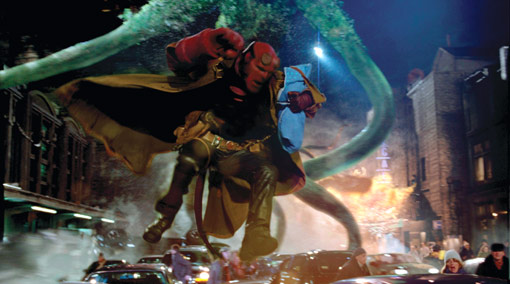
More Monsters
It all started in 2007, when Butler flew to Los Angeles with Double Negative CEO Alex Holt and digital effects supervisor Andrew Chapman to meet with del Toro. “From the moment we met Guillermo, he said that Hellboy II was an animated film,” Butler says. “He wanted it to be very rich, with lots of creatures and other crazy stuff. He wanted it to be the kind of film that you could keep going back to and discovering new things in the background.”
Next, del Toro took the Double Negative crew to a meeting with the team at Spectral Motion, which did suit work and creature design on the film, to see characters in different stages of development. It was clear that the job would be enormous. “It was exciting and terrifying,” Butler admits. “We hadn’t worked on a project this big since Pitch Black.” In all, Double Negative created 761 shots for the film, with a small group of subcontractors (Cube FX, Lipsync, The Senate, Baseblack and Rushes) contributing even more work.
The team was broken down into categories and subcategories, making it clear exactly which personnel would be involved in each sequence. Once the relevant animation and CG leads were on set to supervise photography, Guillermo made a point of soliciting their input on how a scene could be shot to make the most of the FX work. Meanwhile, Butler stayed at the office, making sure the characters were getting built and modeled appropriately.
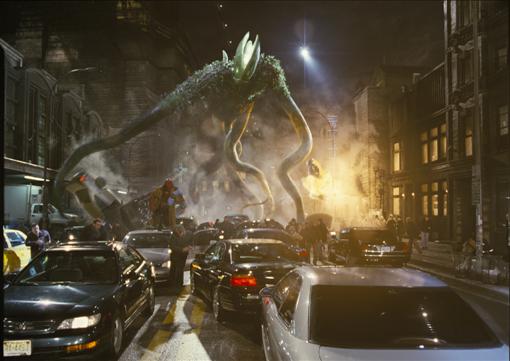
A Sense of Scale
A good example of Double Negative’s approach is the film’s centerpiece action sequence, which involves a huge, organic elemental creature that smashes up a neighborhood trying to kill Hellboy. The problem was one of scale. Because the creature was made from essentially one type of material, it was typical to convey his enormousness. And when wobble and jiggle was added to the character, he started to seem a lot less threatening.
“Colin McEvoy was the animator on that character, and he had one of the toughest jobs on the show,” Burton says. “He had to come up with a unique way for this character to move down the street that didn’t look silly. And it had to have a face that formed as he came up out of the ground. You’re supposed to be able to register how this character is feeling, but at the same time he needed to look cool and big and heavy.
“We added a thing that we called the ‘pimp coat’ to the character,” Burton continues, describing a layer of vines and leaves that covers what would be the creature’s shoulders and back. In the final shots, the creature is animated by hand, but those organic coverings that give important visual clues to its size and power are done procedurally. “When his legs drop quickly and hit the ground, you can tell his strength – not because he’s reacting to the hit, but because all the extra vines and leaves on his body would shake and flick off water and kick off steam and so forth. Christophe Ammann was the CG lead on the character, and he came up with some amazing stuff.”
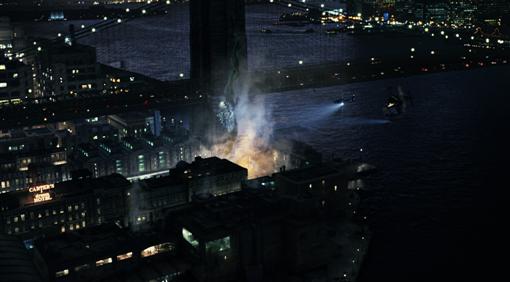
The elemental grows underground and then bursts through the pavement. (Footage of a bomb going off on a road in Iraq was used as reference for that shot.) Double Negative also created shots depicting the creature’s interaction with buildings, including a manga-inspired image of roots growing into one building and CG cars being picked up and mangled or sent bouncing end over end down the streets. Last but not least, digital set extensions were created to merge the studio backlot with a virtual set including the Brooklyn Bridge and a New York City skyline.
At the end of the scene, Hellboy shoots the creature, who is identified as the last of its kind in the world. It’s a bittersweet moment, which is driven home as the creature spews out green goop that covers its surroundings and becomes a layer of moss, grass and other natural material growing on the Brooklyn street surfaces. In-house fluid-simulation tools were used to create those effects.
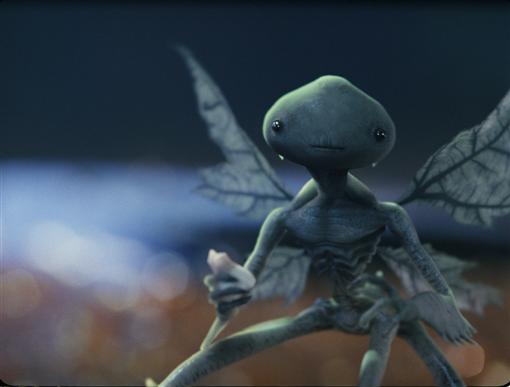
A Thousand Vicious Chihuahuas?
For even more complicated scenes, Double Negative developed new techniques. In the sequence depicting an attack on Hellboy and his friends by a swarm of Tooth Fairies, thousands of the animated beasts had to appear on screen at the same time. They’re miniature, malignant little creatures with huge sets of teeth and voracious appetites. Del Toro said they were like vicious Chihuahuas.
“We did an awful lot of behavior tests with the Tooth Fairy,” Butler says. “We figured out different ways to make it walk, crawl, fly, and so forth. And that fed directly into another system that we wrote called Swarm, a particle-based system that allowed us to generate a particle simulation within the set that was controlled via NURBS curves.” Animators could draw curves, and then specify a series of behaviors for one of the Tooth Fairies to engage in – fly in one direction, turn suddenly, spread out, tighten up, land. The system would transition through the appropriate animated behaviors in sequence.
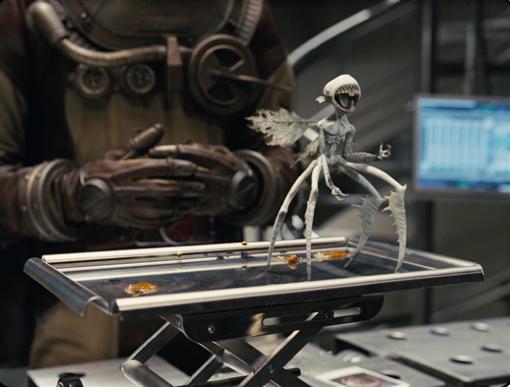
“We were quickly able to see thousands of these characters flying around in a room, landing on walls, taking off from walls, landing on a character, going into an attack or a craw, or whatnot, depending on what we were animating. We would test the animations fairly blindly, feed it into the system, see what it looked like, and then make adjustments [to the behavior animations] based on what we saw. A lot of our pre-production time was spent doing that, and it paid off farther down the line.” All that work was inspired in part by Double Negative’s experiences on The Reaping, for which it laboriously created shots showing a huge locust swarm. “We thought, ‘Let’s not go through that again.'”
Double Negative figured out a way to take multiple passes at the heavy lifting, layering the swarm of creatures into the scene by animating just a few monsters at a time. “We built what we call a geometry-caching system, which allowed the animator to import an animatable rig into a scene, click a couple of buttons, and switch that rig to just animating geometry,” Butler says. “In other words, it would lighten the rig to almost nothing, but you would still have the character in the scene. You could animate five or six characters at one time, do a pass, animate them, and then cache them to geometry and bring in another five characters. You animate those, cache those out, and keep on doing that. You can have up to 60 or 70 characters in a scene and still have all that information represented on screen in 3D.”
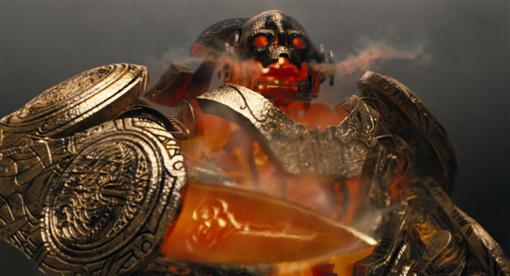
Endorphin Machines
Double Negative also came up with special procedures for animating the dozens of robots, each of them comprising 100 moving parts, that make up the Golden Army in the film’s climactic action sequence. “We found that we could use programs like [NaturalMotion] Endorphin to do some physical simulations,” Butler said. “When a robot gets knocked over and falls to the ground and smashes, those things are quite difficult to animate and make them look real, so we would use Endorphin to knock over a proxy version of a rig instead. You would instantly get something that would look heavy and dynamic. It wouldn’t necessarily look pretty, but we weren’t going for pretty. We were going for brutal, realistic and heavy.
“We used Endorphin quite a lot to do rough passes on our damaged robots, but then as we got to finishing them, we would do it by hand and just use the Endorphin work as reference, to get us halfway there. It’s a much more intuitive process.”
One-Shot Wonders
The flip side of those highly elaborate sequences that demanded their own special procedures was a surprising number of throwaway shots, in which creatures are glimpsed once or twice, in or out of focus, and never return. “Guillermo had a maquette made for another movie. He said, ‘That’s not getting made, so let’s put this in Hellboy.’ We found a spot for it in the Troll Market, but he gave us some ideas for throwaway shots.” Such as? “We’re in the Bureau for Paranormal Research and Defense [BPRD] facility, and the heroes walk past an open doorway. Behind the actors, sort of out of depth of field, you have this monster with tentacles and flailing arms being held down on an operating table as four or five BPRD agents are trying to interrogate it.”
The team also imported hundreds of pixies from del Toro’s previous fantasy film, Pan’s Labyrinth, and set them to flying around the Troll Market – a gathering of creatures underneath the Brooklyn Bridge that was inspired by the cantina sequence from Star Wars – being mischievous. Double Negative spent four months building a digital character called the Berserker. “We had a muscle build, facial – all kinds of interesting things. He was a crazy-looking guy. One shot and he’s gone.”
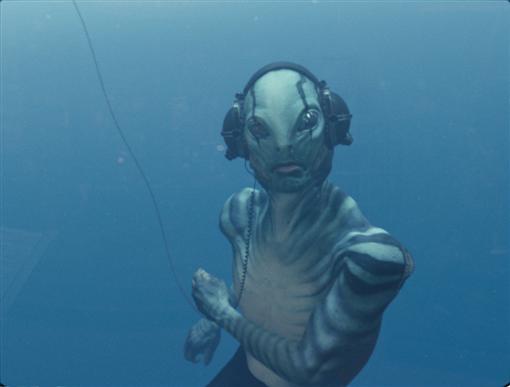
But one of the shots Butler is most proud of involved a digital build of Abe Sapien, for a scene showing him floating in his tank of water. “It’s very much like a shot they did in the last Hellboy movie, and for me that was a really big challenge,” Butler explains. “Everyone has seen Phil Tippett’s work on the first film, and it’s done to an incredibly high standard that still holds up today. I thought, ‘Wow, we have to at least do it as good as that.’ We went all out – full muscle systems, skin, great shaders, just for one or two shots.
“Guillermo showed the shot to [Children of Men director] Alfonso Cuarà³n and he asked, ‘What do you think of that?’ Alfonso said, ‘Well, what did you do? Wire removal? What?’ ‘No,” Guillermo replied, ‘that was all digital.’ And Alfonso, in his own colorful way, was blown away. That was nice for us to hear.”
Did you enjoy this article? Sign up to receive the StudioDaily Fix eletter containing the latest stories, including news, videos, interviews, reviews and more.










Leave a Reply